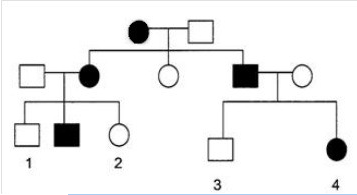Below is a pedigree of a human genetic disease in which solid color indicates affected individuals. Assume that the disease is caused by a gene that can have the alleles A or a. Based on this pedigree, what is the most likely mode of inheritance?

A) Dominant
B) Recessive
C) Either dominant or recessive
D) Cannot be determined
A) Dominant
You might also like to view...
An individual will _______ if that person is missing an X chromosome.
a. have mild mental and physical defects b. be sterile c. be born with Down Syndrome d. not develop at all
Describe the instinctive pattern typical of newly hatched cuckoos
What will be an ideal response?
The somatic cells of a privet shrub each contain 46 chromosomes. How do privet chromosomes differ from the chromosomes of humans ,who also have 46?
A) Privet cells cannot reproduce sexually. B) Privet sex cells have chromosomes that can synapse with human chromosomes in the laboratory. C) Genes of privet chromosomes are significantly different than those in humans. D) Privet shrubs must be metabolically more like animals than like other shrubs.
One difference between eukaryotic and prokaryotic cells is that eukaryotic cells ________ prokaryotic cells
A) have DNA, which is lacking in B) have membrane-enclosed structures called organelles, which are lacking in C) have a plasma membrane, which is lacking in D) have a nucleoid region, which is lacking in